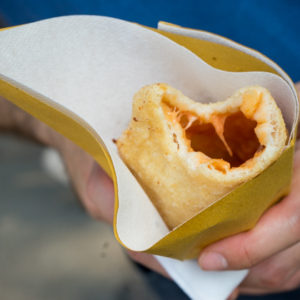Everyone has their ideal Christmas dinner in mind, usually featuring a statement dish. The choice between turkey, ham, roast beef or goose as the pièce de résistance often is less of a question than if to cook them differently this year or spice up the side dishes. While I adore roast turkey, if I get invited to a Thanksgiving dinner, I find it too much to stomach twice in a month. Ham and roast beef I think of slightly pedestrian for the most magical day of the year.
For me, it has to be a roast goose, not only because it is seasonal and pairs well with chestnuts, Savoy cabbage, quince and apples but also because its snow white fat is makes an unparalleled, perfectly crisp roast potatoes. Goose can also be smoked or stuffed with sausages, goose liver, pancetta and rice. As an extra bonus, goose liver, or foie gras (fegato grasso), was a highly regarded delicacy by the Romans and remains so today. Goose has been popular in Piemonte, Lombardia, Veneto and Friuli since the classical era since they are easy to breed, grow quickly, have the most growth per food input and their feathers and fat have many uses. Jews have traditionally substituted pork successfully with goose and in the areas where they lived in Italy, there are many inventive goose recipes. In Britain, there is another documented use of goose fat which makes me grateful for modern central heating, which was the smearing of goose fat over the body before sewing oneself into long johns to survive cold winter nights.
When you store your goose, remove all the packaging before putting it in the refrigerator so that the skin crips nicely when roasted. We typically roast ours with apples but this year we may try quince. The goose gets stuffed with rosemary, sage, bay leaves and apples and roasted while basted with white wine and cognac. When done, the apples are retrieved and pureed to be served alongside the roast goose. This year we will do a soft polenta with roast pumpkin and sautéed wild mushrooms as side dishes. I choose a slightly tart apple like a bramley to cut through the unctuous, soft goose meat.
Oca con mele (roast goose with apples)
For step-by-step illustrated instructions, click here.
2.5 kilos (5 1/2 pounds) goose (can substitute with duck), room temperature
5 apples, peeled and sliced
3 branches rosemary, rinsed and dried
8 sage leaves, rinsed and dried
50 ml (1/4 cup) cognac
250 ml (1 cup) white wine
Black pepper, freshly ground
Preheat the oven to 200C (400F). Rub the goose with salt and pepper inside and out. Stuff the goose with the apples, rosemary and sage. Prick the skin all over with a fork. Place the goose on a rack in a roasting tray or pan breast side down and pour the cognac and white wine over top. Put the goose in the oven and roast for 1 hour. Reduce the heat to 160 C and turn the goose over and baste it. Remove as much fat as you can with a ladle or a turkey baster and reserve. Put back in the oven and roast for another hour, basting every 20 minutes until done. If the juices run dry, add more white wine and water to the pan to keep the goose moist. When the goose is done, remove the goose from the oven. Remove the stuffing and place a sheet of foil over the goose and allow it to rest for 30 minutes. Meanwhile puree the apples. Slice the goose to serve with the apples. Separate out the fat from the juices. The juices can be served with meat and the fat can be used to roast potatoes.









Leave a Reply